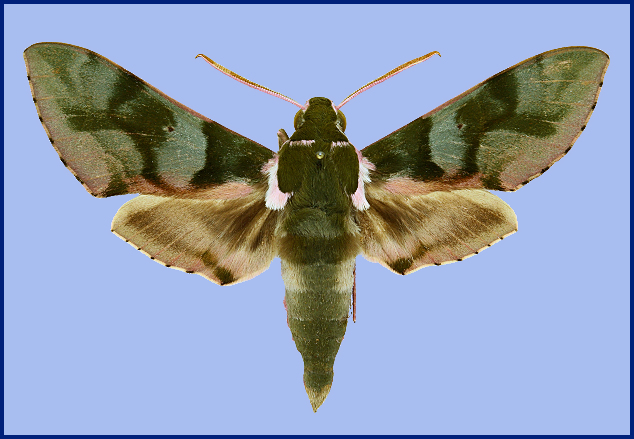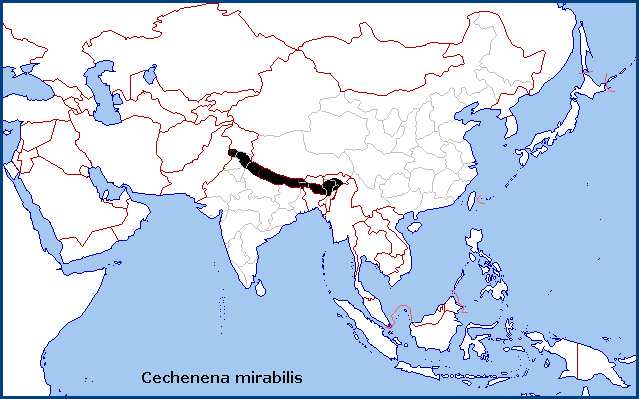
Chaerocampa mirabilis Butler, 1875, Proc. zool. Soc. Lond. 1875: 248. Type locality: Northwest Himalayas.
Synonym. Theretra mirabilis Kirby, 1892.
Note. Transferred to Cechenena by Rothschild & Jordan, 1903, Novit. zool. 9 (suppl.): 799.
Immediately distinguishable from all other species of Cechenena by the blue-green ground colour of the forewing upperside overlaid by a dark green basal and median pattern. Tegulae with a long pale pink apical fringe on the outer margin.Thorax upperside uniform dark green. Abdomen without dorsal lines. Outer row of spines of forebasitarsus double at base; outer midtibial spur shorter than in Cechenena aegrota; spines of midtarsal comb stout and quite short; those of the hindtarsal comb very little elongated. Forewing upperside ground colour blue-green, with a dark green basal area and a vaguely H-shaped patch just distal to the small and indistinct pale discal spot. Antennae apically clubbed. Uncus similar to Rhagastis velata. Gnathos similar to Rhagastis velata. Valve with more stridulatory scales than in Rhagastis velata. Harpe similar to Rhagastis castor but much longer. Phallus similar to Rhagastis lunata but with the left short and with few teeth and a rather a long right process.

In Simla, India, rather rare at an altitude of about 2100m in forests with medium rainfall (Bell & Scott, 1937).
China: 9.vi (Kyirong/Gyirong/Jilong).
OVUM: Unknown.
LARVA: Full-fed 98mm, horn 5mm, with brown (commoner) and green forms. According to Bell & Scott (1937), in the first instar head and body pale yellow, horn of medium length, straight, black. In the second instar, head distinctly bilobed; body rather thick for its length, segments 4 and 5 slightly tumid; horn of medium length, thick at base and evenly tapering, slightly up-curved; head green, body bluish-green with a transverse row of whitish dots along each secondary ring, the dots larger behind segment 5; an indistinct narrow dorsal stripe on 2 to 4; an eye-spot on 5, oval and oblique, very pale yellow edged narrowly with black except at the upper end; horn with basal half crimson, rest black with a white tip. By the third instar, head degraded orange covered with paler tubercles; body greenish-brown in dorsal area, dull crimson in lateral area, dotted with white, these dots turning to a triangular patch of large white spots above the spiracles of segments 6 to 11, the apex of the triangle dorsad; a white subdorsal spot near the front margin of each of these segments; eye-spot with pupil bright yellow with a brownish spot inside it touching the middle of its front edge and shading into the yellow, the pupil edged narrowly with blue, then more broadly with very dark blue; horn thick at base, tapering first sharply then more gently, up-curved. By the fourth instar, head pale green; segments 2 to 5 of body pale yellowish-brown in dorsal area, degraded pale green dotted with paler green in lateral area, with a narrow dark dorsal stripe and a yellowish subdorsal stripe; rest of body dull crimson, with white dots and spots as in the third instar; eye-spot as in third instar; horn with basal two-thirds crimson, then black with the tip translucent white. In the final and fifth instar, shape as in the genus Rhagastis. Head dull, covered with small round tubercles. Body smooth and dull except for the eye-spot, which is shining as though enamelled; horn short or of medium length, slightly down-curved, tapering evenly to near the tip, where it abruptly narrows to a blunt point; surface dull, covered sparsely with shining pointed tubercles directed distad, except on the extreme tip.
In the green form, head dark green, eyes brown. Body: segment 2 green, 3 and 4 pale yellow in dorsal area, green in lateral area: dorsum of fifth segment yellowish-green, pale yellow between the eye-spots, lateral area bright green; rest of body very pale green with short stripes across the secondary rings, alternately very pale blue and very dark green; two large subdorsal pale blue spots on each segment from 6 to 11; a narrow dark green dorsal stripe from front margin of 3 to near base of horn; an ill-defined pale green dorso-lateral stripe on 3 and 4; eye-spot on 5 rather small, oval, the long axis inclined backwards and upwards at an angle of about 30°, lower front part of pupil very deep blue, upper hind part yellow, the pupil edged above and below with dark olive-green dotted with pale yellow, the whole edged narrowly with white and then dark green; broad ill-defined very pale blue zigzag dorso-lateral stripe from 6 to base of horn, edged above with short dark green stripes. Horn pale yellow with self-coloured tubercles, the extreme tip black; legs flesh-colour. Spiracles ochreous with a dark green rim.
In the brown form the head is brown, segment 2 degraded yellowish-brown, 3 to 5 muddy-brown, dorsum pale ochreous; a greenish-ochreous dorso-lateral stripe, edged above with dark brown, from segment 3 to eye-spot; subdorsal spots as in the green form; eye-spot with lower front part of pupil dark blue, upper hind part brown spotted with yellow, pupil edged narrowly with pale blue in front, more widely with white behind, the whole edged narrowly with dark brown; a zigzag dark brown dorso-lateral stripe from segment 6 to base of horn, the body above it marked with short stripes across the secondary rings, alternately dark brown and degraded white, below it degraded white with a few dark stripes; broad ill-defined dark brown oblique stripes on 5 to 10. Spiracles ochreous with the slit edged with brown on each side and the rim brown (Bell & Scott, 1937).
PUPA: Unknown.
Larval hostplants. Vitaceae. Reared on Vitis (Bell & Scott, 1937).
Unknown.
China: Xizang/Tibet (Kyirong/Gyirong/Jilong, XigazÍ/Rikaze/Shigatse Prefecture).
Occurs along the southern edge of the Himalaya, from northern Pakistan (Azad Jammu and Kashmir; Khyber Pakhtunkhwa (Haxaire, Gujjar & Saeed, 2017)) to Sikkim (Bell & Scott, 1937), Assam and the Naga Hills of northeast India, and north just into Xizang/Tibet, China.

Holarctic; eastern Palaearctic region. Pleistocene refuge: Monocentric -- eastern section of Sindian refuge.
 Return to Sphingidae of the Eastern Palaearctic species list
Return to Sphingidae of the Eastern Palaearctic species list